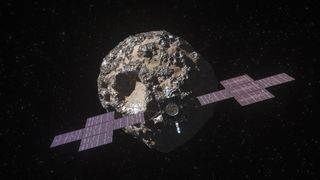The Moon is emerging as a focal point for global space endeavors in the coming years. In a significant development set for 2025, NASA’s Artemis III mission is poised to achieve a historic landing, marking the first time astronauts, including the first woman and first person of color, will set foot on the lunar surface since the Apollo Era concluded over fifty years ago.
Under the framework of the Artemis Accords, multiple international space agencies, including those from Europe, Canada, Japan, and various other nations, are gearing up to send their astronauts to join the lunar exploration effort. Following closely, taikonauts from China, cosmonauts from Russia, and vyomanauts from India will engage in valuable research and exploration endeavors.
The establishment of facilities in lunar orbit, such as the Artemis Base Camp and the International Lunar Research Station, promises to unlock numerous scientific opportunities that are unattainable on Earth or in Earth’s orbit. Notably, this includes the realm of radio astronomy, which stands to benefit greatly from the absence of terrestrial interference on the Moon’s far side, providing heightened sensitivity to previously uncharted cosmic eras. A pioneering initiative known as the Lunar Surface Electromagnetics Experiment-Night (LuSEE-Night) is set to embark on this mission next year, dedicating the ensuing 18 months to listen to the mysteries of the cosmos.
For an extended period, astronomers have yearned to explore the “Dark Ages” of the Universe, one of its earliest evolutionary phases, commencing approximately 380,000 years after the Big Bang. During this epoch, the Universe was replete with neutral hydrogen, the building blocks from which the first stars and galaxies took shape.
As time unfolded, the first stars, referred to as Population III, coalesced into galaxies, gradually ionizing the neutral hydrogen. This transition marked the era known as Cosmic Dawn or the Epoch of Reionization, occurring approximately one billion years post-Big Bang, rendering the Universe transparent to light and thereby visible to modern-day instruments. Given that the formation of the initial stars and galaxies transpired during the Dark Ages, astronomers are keen to explore this epoch and trace the evolution of cosmic structures from their inception.
Regrettably, the only sources of light during this period were the remnants of radiation stemming from the Big Bang, manifesting today as the Cosmic Microwave Background (CMB), and photons liberated as the first neutral hydrogen atoms formed and settled into stable states, a phenomenon known as recombination and decoupling.
This light is discernible solely as the spectral line resulting from a change in the energy state of neutral hydrogen, alternately termed the 21-cm line or the “hydrogen line.”
Earth-based measurement of this line is unfeasible due to atmospheric absorption, refraction, and reflection, which disrupt radio signals before they can be detected by ground-based instruments. Furthermore, any radio signals traversing such vast cosmic distances and time periods would be overwhelmed by terrestrial radio interference, originating from electronic devices, broadcast towers, communication satellites, and the like.
However, the Moon holds a distinct advantage as a natural shield against Earth’s radio waves, offering a “radio quiet” environment on its far side, free from terrestrial interference. This pristine lunar location permits sensitive radio antennas to detect radiation from the ancient epoch and gather data during lunar nights, lasting two weeks, when solar radio waves do not interfere.
With several missions to the Moon on the horizon, numerous proposals have surfaced for constructing lunar radio observatories.
As Kaja Rotermund, a postdoctoral researcher at Berkeley Lab, expressed in a recent statement:
“Being situated on the far side of the Moon provides a pristine, radio-quiet environment for attempting to detect signals from the Dark Ages. LuSEE-Night is a pioneering mission, exploring our ability to conduct such observations from an uncharted location and within a frequency range previously inaccessible.”
The LuSEE-Night project embodies a collaboration between NASA and the Department of Energy (DoE), featuring partners from the Lawrence Berkeley National Laboratory (Berkeley Lab), the Brookhaven National Laboratory, UC Berkeley, and the University of Minnesota.
The Berkeley Lab team is presently in the process of constructing the experiment’s antenna, tasked with listening to the cosmic radio waves emanating from the Dark Ages. The mission is scheduled for launch to the Moon by 2025, where it will undergo testing in the lunar environment.
While lunar radio observatories offer numerous advantages over their Earth-based counterparts, they must contend with significant challenges arising from the Moon’s extreme conditions. These include extreme temperature fluctuations over the course of a lunar day and night, lasting two weeks each.
During a lunar day, temperatures can soar to 120 °C (250 °F) before plummeting to -173 °C (-280 °F) at night. Additionally, because the Moon’s far side never faces Earth, direct communication is impossible, necessitating data transmission through a relay satellite. As Aritoki Suzuki, leading the antenna project for Berkeley Lab, stated:
“The mere feat of landing a scientific instrument on the far side of the Moon is a monumental achievement. Demonstrating our ability to reach, deploy, and survive through the lunar night can pave the way for the scientific community and future experiments.”
To capture radio waves from the ancient Universe, LuSEE-Night will rely on two pairs of antennas, each measuring six meters (~20 ft) in length. These antennas are designed to be compactly coiled, fitting within a payload fairing measuring just one meter (3.3 ft) on all sides.
Upon reaching the lunar surface, LuSEE-Night will employ a spring-loaded “stacer” mechanism to uncoil the antennas into their operational position. To mitigate radio noise interference originating from other celestial bodies, galaxies, and lunar regolith variations, the Berkeley Lab team is developing a turntable that will periodically rotate the antennas.
The project recently completed a technical review and is now collaborating with the UC Berkeley Space Science Laboratory to fabricate the flight model bound for the Moon. The team aims to finalize the antenna subsystem by January 2024 and integrate it with other components.
The full experiment is slated for launch in 2025, courtesy of Firefly Aerospace, as part of NASA’s Commercial Lunar Payload Services (CLPS) program.






